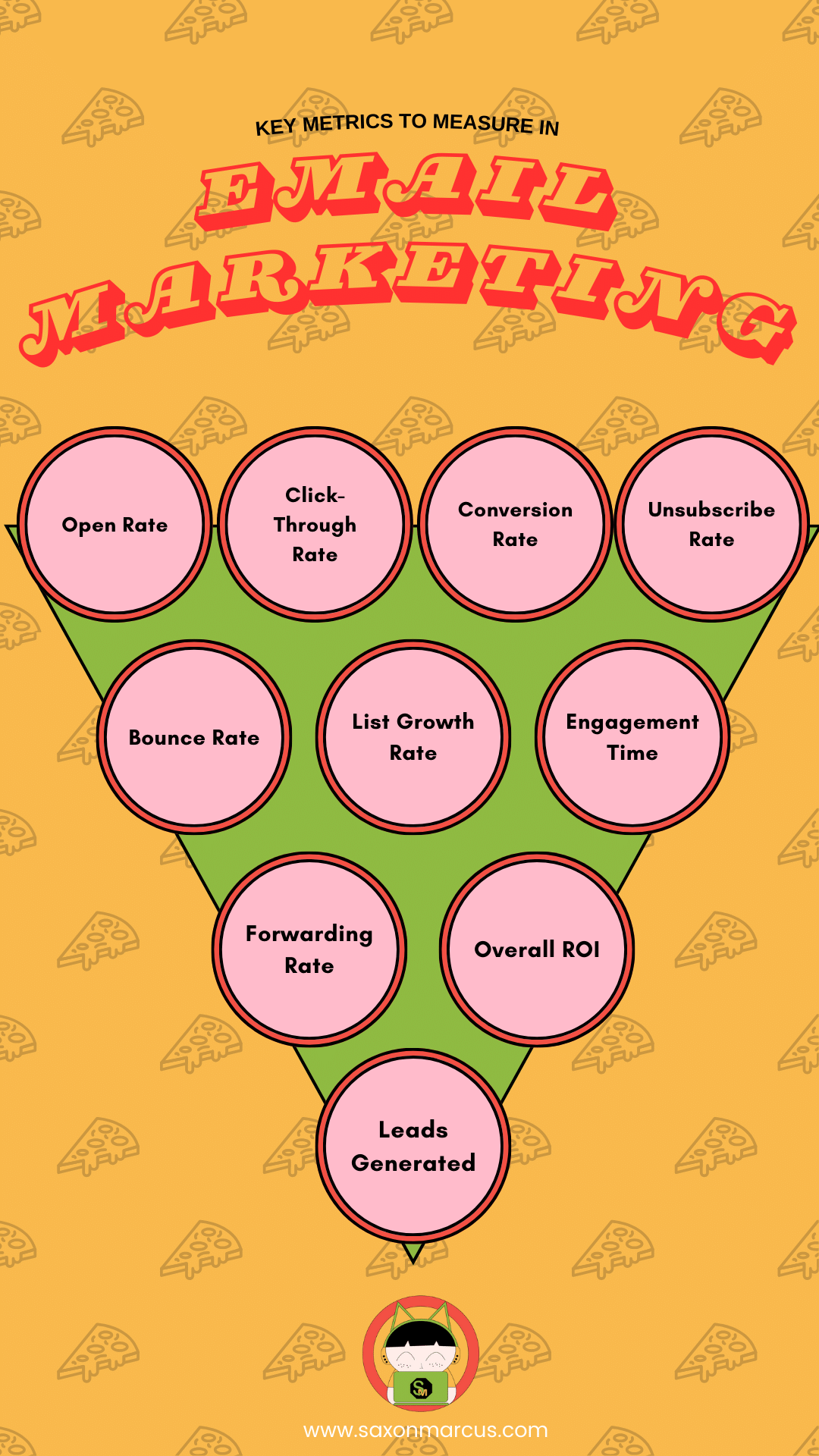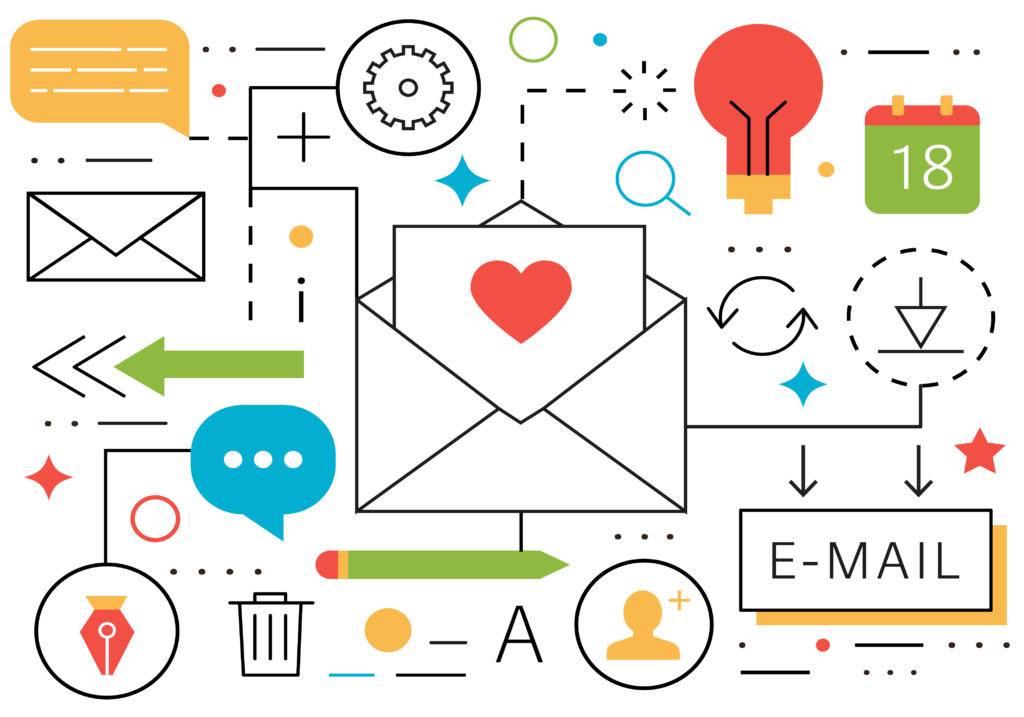
Email marketing has been around for decades, but it remains a vital tool for businesses to connect with their customers. With the rise of digital marketing and social media, many people and digital media agency have predicted the death of email marketing, but this couldn’t be further from the truth. In fact, email marketing has one of the highest ROI’s of any marketing tactic. However, in order to make the most of this powerful tool, you need to understand the metrics that matter.
Email marketing optimization is a powerful tool that can significantly impact the success of both an email digital media agency and clients. By carefully analyzing and refining email marketing strategies, businesses can enhance engagement, increase conversions, and ultimately drive revenue growth. In today’s competitive digital landscape, it is essential to understand the key metrics and best practices that can lead to successful email campaigns.
Effective email marketing optimization goes beyond simply sending out mass emails; it involves a strategic approach that considers factors such as audience segmentation, personalized content, timing, and performance tracking. By leveraging data-driven insights and analytics, an email digital media agency and clients can tailor their email campaigns to meet the specific needs and preferences of their target audience.
In this blog post, we will delve into the fundamentals of email marketing optimization, exploring the importance of metrics such as open rates, click-through rates, conversion rates, and more. By mastering these metrics and implementing proven optimization techniques, businesses can unlock the full potential of their email marketing efforts and achieve sustainable success in today’s dynamic digital landscape.
KEY METRICS TO MEASURE EMAIL MARKETING SUCCESS FOR AN EMAIL DIGITAL MEDIA AGENCY
When it comes to optimizing email marketing campaigns, understanding key metrics is essential for both an email digital media agency and clients to gauge success accurately. By tracking these metrics, you can gain valuable insights into the effectiveness of your email campaigns and make data-driven decisions to improve performance.
One crucial metric to monitor is the open rate, which indicates the percentage of recipients who opened your email. A high open rate suggests that your subject line and sender name are engaging, while a low open rate may signal that adjustments are needed to capture recipients’ attention.
Click-through rate (CTR) is another vital metric that measures the number of recipients who clicked on links within your email. A high CTR indicates that your content is compelling and drives action, while a low CTR may indicate that your messaging or call-to-action needs refinement.
Conversion rate is a key metric that measures the percentage of recipients who completed a desired action, such as making a purchase or signing up for a webinar, after clicking on a link in your email. By tracking conversion rates, you can assess the effectiveness of your email campaigns in driving real results and optimizing for success.
Overall, by monitoring these key metrics and leveraging data-driven insights, an email digital media agency and clients can refine their email marketing strategies, enhance campaign performance, and ultimately achieve greater success in engaging and converting recipients.
Open Rate: Understanding And Improving Engagement
Open rate is a crucial metric in email marketing that indicates how many recipients actually opened the email you sent. Understanding and improving this metric is essential for maximizing engagement and ultimately driving conversions.
To improve open rates, start by crafting compelling subject lines that grab the recipient’s attention and entice them to open the email. Personalization, curiosity-inducing statements, and urgency can all be effective tactics to increase open rates.
Segmenting your email list based on factors like demographics, behavior, or past purchases can also help improve open rates. By sending targeted, relevant content to specific segments of your audience, you can increase the likelihood that recipients will open and engage with your emails.
Testing different elements of your emails, such as send times, sender names, and email content, can provide valuable insights into what resonates best with your audience and can lead to higher open rates.
Regularly monitoring and analyzing your open rates, along with other key metrics, will help you optimize your email marketing campaigns for email digital media agency and client success. By understanding and improving engagement through open rates, you can create more effective and impactful email campaigns that drive results.
Click-Through Rate: Driving Traffic And Conversions
Click-through rate (CTR) is a crucial metric in email marketing as it directly reflects the effectiveness of your email campaigns in engaging your audience. CTR is a crucial metric for all email marketers to track, as it gives direct insight into how many people on an email list are engaging with the content and interested in learning more about a brand or offer.
A high CTR indicates that your email content resonates with your subscribers and motivates them to take action by clicking on your links. This not only drives traffic to your website but also increases the chances of conversions.
To improve your CTR, focus on crafting compelling subject lines that entice recipients to open your emails. Personalization, relevance, and a sense of urgency can all contribute to higher CTRs. Additionally, ensure that your email content is visually appealing, concise, and includes clear call-to-action buttons that encourage clicks.
Monitoring and analyzing your CTR over time can provide valuable insights into the effectiveness of your email campaigns. By testing different elements such as subject lines, content, images, and CTAs, you can optimize your emails for higher engagement and ultimately drive more traffic and conversions for your email digital media agency or client.
Conversion Rate: Turning Leads Into Customers
Conversion rate is a crucial metric in email marketing that directly impacts the success of your campaigns. It measures the percentage of leads that turn into actual customers, indicating the effectiveness of your email content and strategies in driving actions from your audience.
To optimize your conversion rate, it’s essential to focus on crafting compelling and personalized content that resonates with your subscribers. Tailoring your emails to meet the specific needs and preferences of your audience can significantly increase the likelihood of them taking the desired action, whether it’s making a purchase, signing up for a service, or engaging with your brand in other ways.
In addition to content, optimizing the design and layout of your emails can also play a significant role in improving conversion rates. A visually appealing and user-friendly email template that highlights key information and calls-to-action can help guide subscribers towards making a purchase or completing a desired action.
By consistently monitoring and analyzing your conversion rate metrics, you can gain valuable insights into the performance of your email marketing campaigns and make data-driven decisions to enhance your overall success in converting leads into loyal customers.
Unsubscribe Rate: Managing Subscriber Churn
Managing subscriber churn, as indicated by the unsubscribe rate, is a critical aspect of maintaining a healthy email marketing campaign. While it can be disheartening to see subscribers opting out of your communications, it’s essential to view unsubscribes as an opportunity for refinement rather than a setback.
Analyzing the reasons behind unsubscribes can offer valuable insights into the effectiveness of your email content, frequency, and targeting. If a significant number of subscribers are opting out after a particular type of email or campaign, it may indicate that the content is not resonating with your audience or that your frequency is too high.
To manage subscriber churn effectively, consider implementing strategies such as segmentation to deliver more targeted content, optimizing your email frequency based on subscriber engagement levels, and regularly reviewing and refining your email content to ensure relevance and value to your audience.
By monitoring and actively addressing unsubscribe rates, you can refine your email marketing strategy to better meet the needs and preferences of your subscribers, ultimately leading to higher engagement, retention, and success for both your email digital media agency and clients.
Bounce Rate: Ensuring Email Deliverability
Ensuring a low bounce rate is crucial for maintaining good email deliverability. Bounce rate refers to the percentage of emails that were not successfully delivered to the recipient’s inbox. There are two types of bounces: hard bounces and soft bounces.
Hard bounces occur when an email cannot be delivered due to a permanent issue, such as an invalid email address or a blocked domain. Soft bounces, on the other hand, are usually temporary issues like a full inbox or a server problem.
High bounce rates can negatively impact your email sender reputation and deliverability rates. Internet service providers (ISPs) monitor bounce rates to determine whether an email sender is trustworthy and legitimate. A high bounce rate may lead ISPs to classify your emails as spam, causing them to be filtered out of recipients’ inboxes.
To reduce bounce rates, it’s important to regularly clean your email list by removing invalid email addresses and updating any outdated information. Additionally, using double opt-in methods can help ensure that subscribers are providing valid email addresses.
By monitoring and managing bounce rates effectively, you can improve email deliverability and increase the success of your email marketing campaigns for both your email digital media agency and clients.
List Growth Rate: Expanding Your Reach
List growth rate is a crucial metric in email marketing that directly impacts the success of your campaigns. Expanding your reach through growing your email list is essential for reaching a wider audience and increasing your chances of conversions. By focusing on increasing the number of subscribers on your email list, you are essentially widening your pool of potential customers who are interested in your products or services.
There are several effective strategies to boost your list growth rate. One of the most common methods is to offer incentives such as discounts, free resources, or exclusive content in exchange for subscribing to your email list. This not only encourages new sign-ups but also helps in retaining existing subscribers.
Another effective way to expand your reach is by optimizing your sign-up forms and placement on your website. Make it easy for visitors to subscribe by ensuring that your sign-up forms are prominently displayed and easy to fill out. You can also experiment with pop-ups, slide-ins, or embedded forms to capture the attention of your website visitors.
Regularly engaging with your subscribers through valuable and relevant content is also key to maintaining a healthy list growth rate. By providing consistent value and building a relationship with your subscribers, you can encourage word-of-mouth referrals and organic growth of your email list.
Monitoring and analyzing your list growth rate metrics regularly will help you identify what strategies are working and where there is room for improvement. By focusing on expanding your reach through list growth, you can set the foundation for successful email marketing campaigns and drive long-term success for your email digital media agency and clients.
Engagement Time: Maximizing Customer Interaction
Engagement time is a crucial metric when it comes to optimizing email marketing campaigns. It’s not just about how many people open your emails but also how long they engage with the content. The longer a customer interacts with your email, the more likely they are to convert.
To maximize customer interaction, focus on creating engaging and relevant content that captivates your audience from the moment they open the email. Use compelling visuals, concise copy, and clear calls-to-action to keep recipients interested and encourage them to spend more time engaging with your message.
Segmenting your email list based on customer preferences and behaviors can also help increase engagement time. By sending targeted content to specific segments, you can ensure that each recipient receives information that is tailored to their interests, increasing the likelihood of prolonged engagement.
Additionally, testing different send times and subject lines can help you determine the optimal conditions for maximizing engagement time. Keep a close eye on your email analytics to track how recipients are interacting with your emails and use this data to refine your strategies for even greater success.
An Email Digital Media Agency Key Metrics: Email Sharing Or Forwarding Rate
Email sharing or forwarding rate is a crucial metric for both an email digital media agency and clients to measure the success of their email campaigns. This metric indicates how engaging and valuable the content of the emails is to the recipients. When recipients find an email interesting or valuable, they are more likely to share it with others, extending the reach of the campaign.
A high email sharing or forwarding rate signifies that the content resonates with the audience and has the potential to go viral, leading to increased brand awareness and potentially new leads. On the other hand, a low sharing rate may indicate that the content needs improvement or that the targeting is off.
To increase the email sharing or forwarding rate, it’s essential to create compelling and valuable content that resonates with the target audience. Personalizing the content, adding social sharing buttons, and creating share-worthy content such as exclusive offers, informative articles, or entertaining videos can all help encourage recipients to share the email with others.
By tracking and analyzing the email sharing or forwarding rate, an email digital media agency and clients can gain valuable insights into the effectiveness of their campaigns and make data-driven decisions to optimize future email marketing efforts for greater success.
Calculating Overall ROI With An Email Digital Media Agency
Calculating the overall return on investment (ROI) is a crucial metric for both an email digital media agency and clients to determine the effectiveness of their email campaigns. To measure the ROI accurately, it is essential to track the total revenue generated from email marketing efforts and compare it against the total investment made in the campaigns.
This calculation provides a clear picture of how profitable the email marketing initiatives have been in driving business growth and achieving the desired outcomes.
In order to enhance the overall ROI, an email digital media agency and clients should focus on optimizing various aspects of their campaigns, such as improving email open rates, click-through rates, conversion rates, and customer retention. By analyzing the ROI data regularly, both parties can identify areas for improvement, refine their strategies, and make data-driven decisions to maximize the profitability of their email marketing investments.
A positive ROI signifies that the email campaigns are delivering value and contributing to the overall success of the business, making it a key metric to monitor closely for long-term success.
Number Of New And Total Leads Generated By An Email Digital Media Agency
One of the key metrics for measuring success in email marketing is the number of new and total leads generated. This metric is crucial for both an email digital media agency and clients as it directly reflects the effectiveness of their email campaigns in attracting potential customers.
By tracking the number of new leads generated, an email digital media agency and clients can assess the growth of their customer base and identify the impact of their email marketing efforts on acquiring new prospects.
Moreover, monitoring the total leads generated provides valuable insights into the overall performance of email campaigns over time. This metric helps in evaluating the long-term success of email marketing strategies and allows an email digital media agency and clients to make informed decisions on optimizing their campaigns for better results.
By setting specific targets for new and total leads generated, email marketing efforts can be aligned with business goals, leading to improved conversion rates and increased revenue.

ANALYZING PERFORMANCE DATA AND MAKING ADJUSTMENTS
Analyzing performance data and making adjustments is a crucial step in achieving great results in email marketing. By closely monitoring key metrics such as open rates, click-through rates, conversion rates, and unsubscribe rates, an email digital media agency and clients can gain valuable insights into the effectiveness of their campaigns. These metrics provide a clear picture of how subscribers are engaging with the emails and help identify areas that need improvement.
Once the performance data is analyzed, it is essential to make adjustments to optimize future campaigns. This could involve tweaking subject lines to improve open rates, refining the content to increase click-through rates, or streamlining the conversion process to boost overall campaign success. By continuously monitoring performance data and making data-driven adjustments, an email digital media agency and clients can refine their strategies and achieve even greater results over time.
Did One Email Outperform Another In Open Rates?
Analyzing whether one email outperformed another in terms of open rates is a crucial metric for both an email digital media agency and clients. Open rates provide valuable insights into the effectiveness of your email campaigns and the engagement level of your audience.
By comparing the open rates of different emails, you can identify trends, patterns, and preferences among your subscribers. This data can help you refine your email marketing strategy, such as understanding what subject lines resonate best with your audience or what types of content are driving higher open rates.
Ultimately, tracking and analyzing open rates allows you to optimize your email campaigns for better performance and ultimately achieve great results in your email marketing efforts.
Are Open Rates Changing With Certain Factors Like Time Of Day Or Frequency?
Analyzing open rates is a crucial aspect of measuring the effectiveness of email marketing campaigns. One factor to consider is the timing of sending out emails. Research has shown that the time of day can significantly impact open rates.
For instance, emails sent in the early morning or late afternoon tend to have higher open rates as people are more likely to check their emails during these hours. Additionally, the frequency of email campaigns can also influence open rates.
Sending emails too frequently can lead to subscriber fatigue and lower open rates, while spacing out emails strategically can help maintain engagement levels. By monitoring open rates in relation to factors like time of day and frequency of emails, an email best digital marketing agency and clients can fine-tune their strategies for optimal results.
Do Customers Click-Through More Often On Particular Types Of Content?
Understanding the types of content that customers click through more often is crucial for the success of email marketing campaigns. By analyzing click-through rates on different types of content, an email experiential marketing agency and clients can gain valuable insights into what resonates with their audience and tailor future campaigns for better engagement.
It is essential to experiment with various content formats such as product promotions, newsletters, blog posts, videos, or infographics to determine which types generate the highest click-through rates.
By tracking and comparing the performance of each content type, marketers can optimize their strategies to deliver more relevant and engaging content that drives higher click-through rates and ultimately improves overall campaign success.
What Are Some Common Email Marketing Mistakes To Avoid?
Avoiding common email marketing mistakes is crucial for achieving success in email campaigns. One of the most common mistakes is sending too many emails too frequently. Bombarding subscribers with emails can lead to higher unsubscribe rates and lower engagement levels.
Another mistake to avoid is not personalizing your emails. Personalization can significantly improve open rates and click-through rates. It’s essential to segment your email list and tailor your content to different subscriber groups. Additionally, neglecting mobile optimization is a common mistake. With the majority of emails being opened on mobile devices, it’s crucial to ensure that your emails are mobile-responsive for a seamless user experience.
Finally, not testing and analyzing your email campaigns is a mistake that can hinder your success. A/B testing different subject lines, content, and send times can help you optimize your campaigns for better results. By avoiding these common email marketing mistakes, you can improve the effectiveness of your campaigns and maximize your success.
CASE STUDIES: SUCCESSFUL EMAIL MARKETING STRATEGIES OF EMAIL DIGITAL MEDIA AGENCY
Case studies are a powerful tool for showcasing successful email marketing strategies that have led to significant results. By examining real-world examples of campaigns that have achieved notable success, an email digital media agency and clients can gain valuable insights and inspiration for their own email local online marketing efforts.
One such case study could focus on a client in the e-commerce industry who implemented a personalized email campaign targeting customers based on their purchase history and preferences. By segmenting their email list and tailoring content to specific customer segments, the client saw a significant increase in open rates and click-through rates, ultimately leading to a boost in sales and customer engagement.
Another case study could highlight a B2B client who utilized automated drip campaigns to nurture leads and drive conversions. By sending targeted emails at key points in the customer journey, the client was able to move leads through the sales funnel more effectively and ultimately increase their ROI.
By delving into these case studies and analyzing the strategies and tactics that led to success, an email digital media agency and clients can gain valuable insights into what works in the world of email marketing. These real-world examples serve as proof points for the effectiveness of email marketing and can help guide future campaigns towards achieving similar levels of success.
TIPS FOR AN EMAIL DIGITAL MEDIA AGENCY AND CLIENTS TO OPTIMIZE EMAIL MARKETING CAMPAIGNS
When it comes to optimizing email marketing campaigns, both a leading digital agency and clients play a crucial role in achieving success. Here are some valuable tips for a leading digital agency and clients to collaborate effectively and maximize the impact of their email marketing efforts:
1. Set Clear Objectives: An email digital media agency and clients should align on the goals of the email marketing campaign from the outset. Whether it’s driving website traffic, increasing sales, or boosting brand awareness, having clear objectives will guide the strategy and execution.
2. Segment Your Audience: Understanding your target audience is key to delivering relevant and personalized content. An email digital media agency should work closely with clients to segment their email lists based on demographics, behavior, and preferences to ensure tailored messaging.
3. Test and Optimize: A/B testing is a powerful tool to optimize email campaigns. An email digital media agency and clients should experiment with different subject lines, content formats, and calls-to-action to identify what resonates best with their audience and continuously improve campaign performance.
4. Monitor Key Metrics: Both an email digital media agency and clients should regularly track and analyze key metrics such as open rates, click-through rates, conversion rates, and unsubscribe rates. By closely monitoring these metrics, they can identify trends, spot areas for improvement, and make data-driven decisions.
5. Foster Collaboration: Open communication and collaboration between an email digital media agency and clients are essential for the success of email marketing campaigns. Regular meetings, feedback sessions, and brainstorming discussions can help ensure that everyone is on the same page and working towards the common goal.
By following these tips and fostering a collaborative relationship, an email digital media agency and clients can optimize their email marketing campaigns, drive engagement, and ultimately achieve success in reaching their target audience.

CONCLUSION
In conclusion, mastering the art of email marketing is a powerful tool for both an email digital media agency and clients to achieve success in the digital realm. By understanding and utilizing key metrics such as open rates, click-through rates, conversion rates, and engagement metrics, a new marketing agency can demonstrate the tangible results of their efforts to clients.
Consistent testing and optimization of email campaigns based on these metrics will lead to improved performance and better ROI for clients. Personalization, segmentation, and automation are key strategies that can help a leading digital agency tailor their email marketing efforts to the specific needs and preferences of clients’ target audiences.
By fostering strong communication and collaboration between a new marketing agency and clients, both parties can work together towards common goals and drive impactful results. Transparency, accountability, and a data-driven approach are essential components of successful email marketing campaigns that deliver value and drive business growth.
In the dynamic landscape of digital marketing, staying ahead of trends, adapting to changes, and continuously refining strategies are crucial for long-term success. By following the path outlined in this guide and staying focused on delivering high-quality, relevant content to subscribers, a new marketing agency and clients can build lasting relationships, drive conversions, and achieve mutual success in the ever-evolving world of email marketing.



